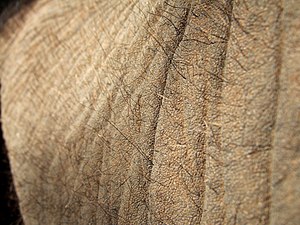This is an old revision of this page, as edited by 96.238.134.167 (talk) at 23:37, 5 December 2017 (skinned the article). The present address (URL) is a permanent link to this revision, which may differ significantly from the current revision.
Revision as of 23:37, 5 December 2017 by 96.238.134.167 (talk) (skinned the article)(diff) ← Previous revision | Latest revision (diff) | Newer revision → (diff) This article is about the outer covering of animals. For skin in humans, see human skin. For other uses, see Skin (disambiguation).| Skin | |
|---|---|
 Skin of an elephant Skin of an elephant | |
| Details | |
| Identifiers | |
| Latin | Cutis |
| MeSH | D012867 |
| TA98 | A16.0.00.002 |
| TA2 | 7041 |
| Anatomical terminology[edit on Wikidata] | |
Skin is the soft outer tissue covering vertebrates.
Society and culture
The term "skin" may also refer to the covering of a small animal, such as a sheep, goat (goatskin), pig, snake (snakeskin) etc. or the young of a large animal.
The term hides or rawhide refers to the covering of a large adult animal such as a cow, buffalo, horse etc.
Skins and hides from the different animals are used for clothing, bags and other consumer products, usually in the form of leather, but also as furs.
Skin from sheep, goat and cattle was used to make parchment for manuscripts.
Skin can also be cooked to make pork rind or crackling.
See also
- Cutaneous respiration - gas exchange conducted through skin
- Hair – including hair follicles in skin
- Moult
- Rawhide
- Role of skin in locomotion
- Skin flora
References
External links
- [REDACTED] Media related to Human skin at Wikimedia Commons
- [REDACTED] The dictionary definition of skin at Wiktionary
| Physiology of skin | |
|---|---|
| Skin physiology | |
| Hair | |
| Superficial fascia and areolar connective tissue | |
| Development of skin | |
|---|---|
| Skin | |
| Skin appendage | |